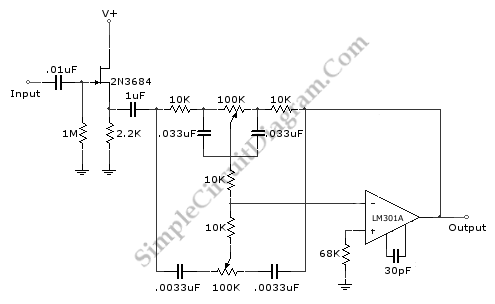High-Impedance Input Hi-Fi Tone Control
Tone control circuit is an electronic circuit which is designed to manipulate the tone of audio signal. Tone of audio signal is analog to color in light. We don’t call the tone of audio signal as red, green or or blue, but we can classify them as bass, mid, and treble. In general, tone control has no mid frequency control, since boosting or attenuating the mid can be approached by attenuating or boosting both bass and treble. If we add a mid-frequency control then we would normally call it a 3-band equalizer, which is actually has similar function with tone control. Here is the schematic diagram of the circuit, showing two potentiometers for controlling the treble (lower pot) and bass tone (upper pot):

The high impedance feature of this circuit is made possible by using JFET (2N3684) as the buffering stage for the input. Hi-Fi or high fidelity is a term for classifying audio device that meet high quality standard, but recently it used more popular as marketing than a technical term which is about frequency response, distortion level, noise figure and other technical parameters. Without measuring actual performance parameters, we can believe that almost all modern op-amp integrated circuit could produce hi-fi standard, as long as it is used in a design that is intended to produce good quality audio and accommodate all audio spectrum 20Hz-20kHz.